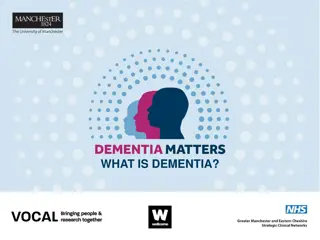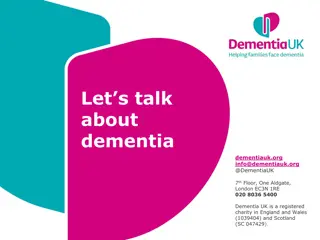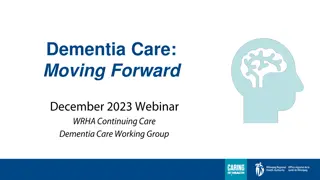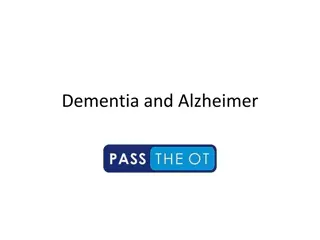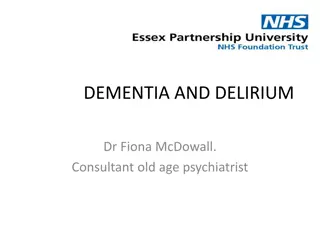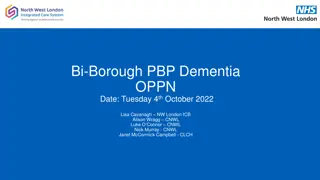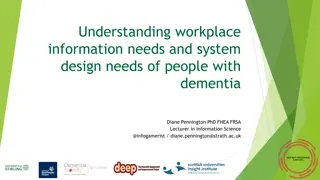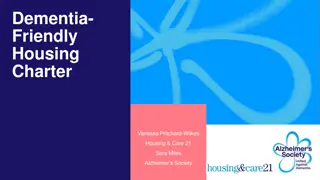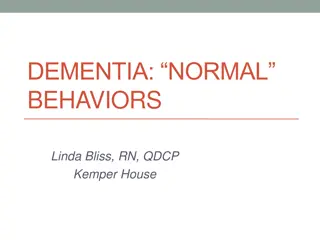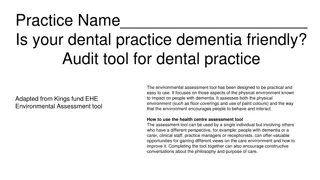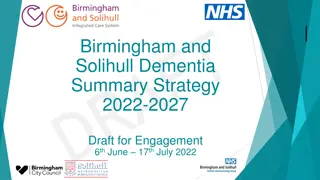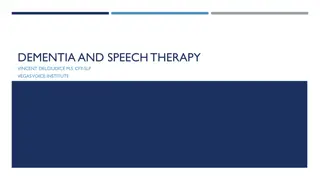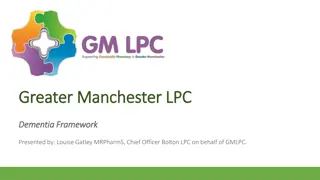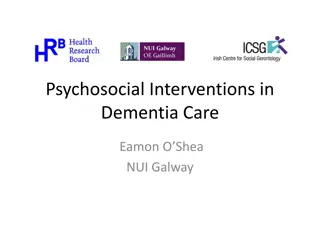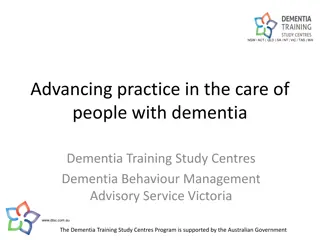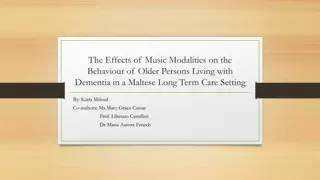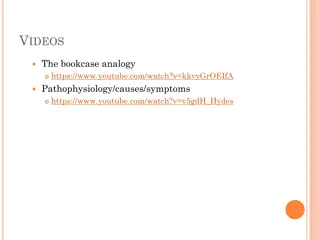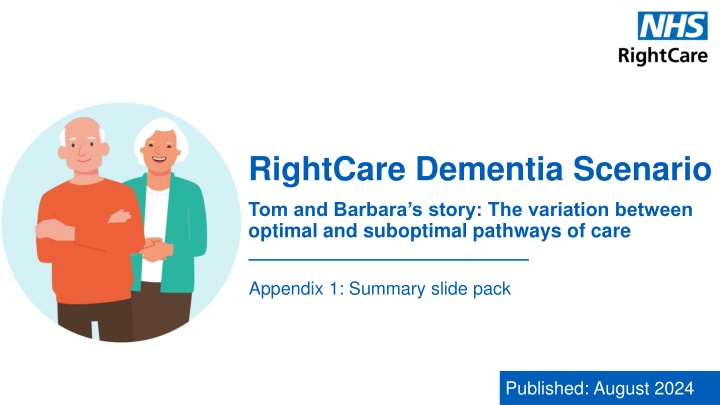
Tom and Barbara: A Dementia Care Journey
Explore the dementia care journey of Tom and Barbara, highlighting the challenges and importance of optimal pathways. Understand the impact of dementia on individuals and the healthcare system, with a focus on early diagnosis and integrated care for better outcomes.
Download Presentation

Please find below an Image/Link to download the presentation.
The content on the website is provided AS IS for your information and personal use only. It may not be sold, licensed, or shared on other websites without obtaining consent from the author. If you encounter any issues during the download, it is possible that the publisher has removed the file from their server.
You are allowed to download the files provided on this website for personal or commercial use, subject to the condition that they are used lawfully. All files are the property of their respective owners.
The content on the website is provided AS IS for your information and personal use only. It may not be sold, licensed, or shared on other websites without obtaining consent from the author.
E N D
Presentation Transcript
RightCare Dementia Scenario Tom and Barbara s story: The variation between optimal and suboptimal pathways of care Appendix 1: Summary slide pack Published: August 2024
Tom and Barbaras story: This is the story of Tom and Barbara s experience of dementia and how it could be so much better. Throughout the pathways we have highlighted the key improvement themes that are important in delivering an optimal pathway. In this scenario we examine a dementia pathway, comparing a suboptimal but realistic scenario against an optimal pathway. 1 2 4 3 This document is intended to help commissioners and providers to understand the implications, both in terms of quality of life and cost, of shifting the care pathway. It shows how the RightCare methodology can help clinicians and commissioners to improve the value and outcomes of the care pathway.
Introduction to dementia Dementia continues to place a huge pressure on the health and social care system. Evidence indicates that people with dementia occupy 25% of acute hospital beds, stay in hospital twice as long and are admitted for infections treatable in the community. 1 in 2 people will be affected by dementia in their lifetime and research estimates that 944,000 people in the UK have the condition, including around 70,000 under the age of 65. One in 11 people over the age of 65 have dementia. This will increase to over one million by 2030 and over 1.6 million by 20505. Hospital admission can trigger distress, confusion and delirium for someone with dementia that can contribute to a decline in functioning and a reduced ability to return home to independent living. In 2021, the estimated cost of dementia in the UK was 25 billion. By 2030 it is estimated that this will rise to 30 billion and in 2050 it will be circa 47 billion6. The health and social care costs for dementia are higher than cancer and coronary heart disease7. In addition, carers of people with dementia provide 1.1 billion hours of unpaid care each year6 and are at increased risk of stress, depression and a variety of other health complications8. The key challenges for the health and care system with regard to dementia are to ensure early and accurate diagnosis and planned integrated care to aid provision of timely and appropriate post diagnostic support.
Introducing Tom and Barbara Tom is 77 years old and is married to Barbara. They have one child, John, 52, and three grandchildren who live nearby. They have been retired since their 60 s. They have always had active social lives and take part in hobbies both separately and together. Tom is a keen walker, loves to sing, and go fishing. Tom has always had an excellent memory and attention to detail, but Barbara notices that recently he has started to get forgetful. He forgets to buy things when out shopping, even if he has a list. He forgot John s birthday, mixes up the grandchildren s names, forgets the names of their friends and repeats himself during conversations. Barbara has also noticed that he often asks her the storyline of their favourite television programmes and struggles to follow the plot.
Tom and Barbara and the suboptimal pathway Year 1: Barbara approaches their GP about Tom s memory loss Barbara is worried about Tom and approaches their GP during her own routine health check. The GP suggests she brings Tom in for an appointment. Barbara speaks to Tom but he refuses to attend. Over the next year, Tom s memory and behaviour gradually deteriorates leading to frustration and arguments. Tom wets himself for the first time, which happens more regularly as the year progresses. One day the police are called after Tom fails to return home after a short walk, he is eventually found in a local park at 11pm. Tom becomes delirious and is admitted to hospital with an infection A few weeks later, Tom becomes more irritable and shouts and throws objects at Barbara. As this was very out of character, she subsequently phones NHS 111 who arrange an appointment with the out-of-hours GP. The GP recognises that Tom is presenting signs of delirium and a potential infection. An ambulance is called and Tom is admitted to hospital. Tom becomes more confused and distressed, which is heightened as Barbara is not allowed to stay with him. He is diagnosed with a UTI. Over the next few weeks, Tom is transferred to three different wards, leaving him scared and adding to his confusion. Tom is discharged from hospital with little support Tom is experiencing urinary and bowel incontinence every day and is wearing wrap-around incontinence pads. Barbara asks the nurses about the urinary and bowel incontinence and is told that it is only to be expected at his age and with his problems . A week later, Tom is ready to be discharged home, his bladder and bowel problems are not assessed and no further options are considered. Tom can no longer recognise the toilet and needs guidance along with a toileting plan. The clinical team assume Tom has a lack of capacity to make decisions about his future needs and do not assess him. A few months later, Barbara asks their GP to assess Tom s mental capacity, it is found to be too late to establish an advance care plan or nominate a Lasting Power of Attorney. Barbara and John are able to make best interest decisions on behalf of Tom. Despite this, Barbara feels uninvolved and helpless in any of the decisions that are taken about Tom s care. Year 3: Tom deteriorates further and is admitted to hospital again Tom becomes highly confused, often failing to recognise Barbara and his surroundings. Barbara calls an ambulance and he is taken to A&E and diagnosed with another UTI. The A&E consultant refers Tom back to his GP to monitor cognition and for onward referral to a memory clinic. Tom remains in hospital for two weeks. Following a referral via his GP, he attends the memory clinic and is diagnosed with Alzheimer s disease and is prescribed an acetylcholinesterase inhibitor. Barbara is given little information about the condition or where to go to for support so leaves feeling isolated. Six months on, day-to-day tasks are much more difficult for Tom. Their social life suffers and Barbara stops going out with friends. Barbara is physically and mentally exhausted and feels stressed and overwhelmed. She knows she is doing her best but is constantly worried that she isn t doing the right thing for Tom. Year 4: Tom is admitted to hospital and is too frail to return home A year since Tom s diagnosis, he has become increasingly frail, has no interest in food and sleeps a lot. Barbara takes him to A&E where he is checked over and admitted for support to increase his weight and to rehydrate. The hospital team, including a social worker, agree Tom is too frail and advanced in his dementia to return home and tell Barbara that he needs to be admitted to a care home. Tom remains in hospital whilst they try and arrange a care home, after six weeks in hospital, Tom contracts pneumonia and dies a week later, aged 80. Barbara is heartbroken and feels guilty that she could not care for Tom at home, where she believes he would rather have been at the end of his life.
Tom and Barbara and the optimal pathway Year 1: GP review and memory clinic referral Barbara visits her GP for a routine health check and approaches them about Tom s memory loss. The GP suggests she bring Tom in for an appointment. During the appointment with Tom, the GP orders blood tests, reviews his medical records and undertakes a brief memory check. Tom is referred to the local memory clinic where he is assessed and diagnosed with mild cognitive impairment. He is referred for support with managing memory and receives a follow-up appointment for six months time. Tom and Barbara are given further advice. Year 2: Tom is diagnosed with Alzheimer s disease After 18 months, Tom attends one of his memory clinic appointments. Tom is referred for a brain scan and is diagnosed with Alzheimer s disease and prescribed with donepezil. Tom and Barbara are signposted to resources and are advised to speak to an Admiral Nurse. The results of Tom s scan and diagnosis are shared with his GP and uploaded to his integrated care record. The memory clinic Dr introduces Tom and Barbara to their Dementia Adviser - Maria, who starts an initial personalised care plan for post diagnostic support. Maria refers Tom and Barbara for Admiral Nurse support and explains what support they can provide. She also signposts to a range of support groups, resources, the local dementia caf , and to dementia research trials. Maria advises on the process of agreeing a Lasting Power of Attorney. Tom is referred for Cognitive Stimulation Therapy (CST). Year 3: Tom is admitted to hospital after a fall Tom is getting up more through the night to go to the toilet and has been caught out a few times. The GP refers him to a specialist continence service. Whilst walking, Tom slips and hurts his leg. He is taken to A&E where he has an x-ray, a comprehensive geriatric assessment, and is assessed for frailty. Whilst in hospital, Tom and Barbara receive support from the Transfer of Care Admiral Nurse - James. Barbara is able to stay the night with Tom and visit him whenever she needs. They are advised that their local area has Frail Hospital and Home Virtual Wards. Tom is discharged the next day with just a bruised leg. Once home, James hands over to Maria, to the community Admiral Nurse, and to other members of the integrated care team (ICT). Due to Tom s deterioration, the GP consults the NICE dementia guideline and starts him on memantine. Tom and Barbara continue to be social and stay active. Year 9: Tom is living well despite his dementia symptoms worsening Tom is now 86, he is more forgetful, becomes agitated in unfamiliar surroundings and begins to experience incontinence regularly. Barbara self-refers Tom to the specialist continence service again for refresher advice and support, they organise for an occupational therapist visit to their home. One day, Tom seems very agitated, delirious, and has a tender red swollen calf. Barbara calls the Urgent Community Response team, who after an initial assessment refers him to the local virtual ward for treatment. An Advanced Clinical Practitioner (ACP) assesses Tom at home, blood tests are taken, and cellulitis is diagnosed. Tom is admitted to the virtual ward. A nurse visits Tom every day to review the infection markers and administer IV antibiotics. Tom is discharged from the virtual ward and continues with oral antibiotics. Year 12: Tom moves into a local care home and dies at the age of 90 Tom is 88 when, after all packages of care have been exhausted, it is agreed to move him into a local care home full time. The GP recognises that Barbara is struggling to come to terms with Tom moving into a home and advises her to see the Admiral Nurse for support. She stays very involved in Tom s care and visits him daily. When Tom dies at the age of 90, Barbara and the care home staff are able to ensure his wishes are fulfilled as they have been documented in his advance care plan. Following Tom s death, the community Admiral Nurse checks in with Barbara and supports her through the grieving process.
Key themes of optimal care Supporting family members and others caring for people with dementia Referral to a specialist dementia diagnostic service People with dementia have a single named practitioner to coordinate their care Access to a range of tailored activities to promote wellbeing Unpaid carers often have high levels of stress due to the physical and mental challenges of caregiving and coping with other responsibilities. It is essential that informal carers have good culturally appropriate support, taking into account their cultural preferences and needs, to enable them to manage the stresses and demands of caregiving and to fulfil their role. Referral to dementia specialist diagnostic services ensures that diagnosis is timely and accurate, and dementia subtypes, such as Alzheimer s disease and dementia with Lewy bodies, can be identified. It also means that people can access support and treatment sooner. Dementia is a progressive condition with symptoms and care and support needs that change over time. People with dementia often have other long-term conditions and many different practitioners might be involved in supporting their health and social care needs. To ensure that people with dementia experience person-centred care, it is important that there is a person responsible for supporting them through the disease course. The symptoms of dementia make it harder for a person to take part in activities, to engage socially, to maintain their independence, to communicate effectively, to feel in control and to care for themselves. Providing enjoyable and health-enhancing activities that are suitable for the stage of dementia can help with this. Understanding the activities that a person prefers, and thinks are suitable and helpful, with the input of family and carers if needed, and adapting them to their strengths and needs, will make a person more likely to engage with the activities offered. The benefits of a timely diagnosis include the person and their family and carers knowing what to expect so that they can consider future mental capacity and make plans early (advance care planning). As per the duty in the Health and Care Act 2022, it is important to involve carers in all decisions around care. The type of support needed will depend on the stage of dementia. During the earlier stages, this might be signposting to different services and support, whereas later it might be coordinating all aspects of their health and social care. The person with dementia can also develop and review a care and support plan with their named person. NICE Quality statement 2: Diagnosis NICE Quality statement 7: Supporting carers NHS England and Alzheimer Europe: Intercultural dementia care guide NICE Quality statement 5: Activities to promote wellbeing NICE Quality statement 4: Coordinating care
Key themes of optimal care Advance care planning is discussed at diagnosis and each health and social care review Preventing well - risk of people developing dementia is minimised A structured assessment should take place before starting treatment for distress As dementia is a progressive condition, it is important for people to be able to make decisions about their future care early on, before they find it difficult to communicate or they lack the capacity to do so. This is known as advance care planning. There is limited awareness among both the public and practitioners that the risk of developing some types of dementia can be reduced, or the onset or progression delayed, through lifestyle changes. Making this clear in interventions and programmes that promote behaviour change, such as NHS Health Checks and stop smoking services, should encourage changes in behaviour in mid-life, which could lead to fewer people developing dementia in later life. People with dementia can become distressed, which can lead to symptoms such as increased aggression, anxiety, apathy, agitation, depression, delusions, hallucinations and sleep disturbances. But these behaviours may have other causes, including pain, delirium or inappropriate care. It is important that there are opportunities to review and change the plan as the dementia progresses and if the preferences or needs of the person change. Having an advance care plan ensures that the person with dementia can receive treatment and care according to their preferences, even when they can no longer express them. Understanding the causes of these behaviours and addressing them before offering non-pharmacological and pharmacological treatment can prevent things getting worse and prevent any harm. It can also avoid the use of unnecessary interventions, such as antipsychotic medication and antidepressants, which may not manage the symptoms effectively. NICE Quality statement 1: Raising awareness - health promotion interventions Alzheimer s Research UK - Think Brain Health Alzheimer s Disease International - Risk factors and risk reduction The Lancet - Dementia prevention, intervention, and care: 2020 report of the Lancet Commission NICE Quality statement 3: Advance Care Planning Universal Principles for Advance Care Planning Dementia UK - Advance Care Planning Alzheimer s Society - Advance Care Planning NICE Quality statement 6: Managing distress Appropriate prescribing of antipsychotic medication in dementia
Financial information The difference between the two journeys to Tom and Barbara s life in terms of quality and outcomes is stark. In the optimal journey, Tom and Barbara are able to maintain a high quality of life doing the things that are important to them and avoid unnecessary hospital admissions. The above summarises the financial costs calculated for the two pathways by health sector/area. National average costs and similar data sources have been used to calculate the indicative healthcare costs of two hypothetical pathways of care for an individual fictionalised typical person, and therefore do not represent the local cost of service provision. It is recommended that systems work with local clinical leaders and costing colleagues to map existing pathways, taking into account local circumstances and evidence, and reflecting the make-up of the local population and services already in place.
Areas for systems to consider Below are some of the questions featured in the scenario. They are to support discussion and investigation within local systems and are focused on the key optimal themes that can lead to improvement in healthcare for people with dementia: How do you promote dementia as a condition for which targeted interventions (including preventative) must be planned and delivered? 1 How do you promote dementia as a condition for which targeted interventions (including preventative) must be planned and delivered? 1 Are there clear and recognised processes for referral to specialist dementia diagnostic services across your system? 2 How do you ensure that people with dementia within your system have a single named practitioner to coordinate their care? 3 How do you ensure that people with dementia are encouraged and given the opportunity to discuss advance care planning at every opportunity throughout their care? 4 What range of activities are offered to people with dementia to promote wellbeing within your local system and how do you ensure these are utilised? 5 What education and skills training is offered to carers of people with dementia in your local system to help them provide effective care and look after their own health and wellbeing? 6 How do you ensure that people with dementia have a structured assessment before starting treatment for distress? 7 Do you regularly review data and use it to identify and drive improvement in dementia care? 8 How do you understand the needs of the current and future health and care needs of your local population with regards to dementia? Have you considered undertaking a Joint Strategic Needs Assessment to address this? 9
Further information For more information about Tom s journey or RightCare: rightcare@nhs.net www.gettingitrightfirsttime.co.uk/academy- resources/population-health/ www.future.nhs.uk/NationalRightCare Click here for the full scenario

